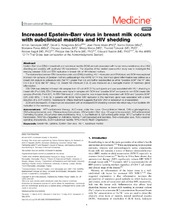| dc.contributor.author | Sanosyan, Armen | en_US |
| dc.contributor.author | Rutagwera, David Gatsinzi | en_US |
| dc.contributor.author | Moles, Jean-Pierre | en_US |
| dc.contributor.author | Bollore, Karine | en_US |
| dc.contributor.author | Peries, Marianne | en_US |
| dc.contributor.author | Kankasa, Chipepo | en_US |
| dc.contributor.author | Mwiya, Mwiya | en_US |
| dc.contributor.author | Tylleskär, Thorkild | en_US |
| dc.contributor.author | Nagot, Nicolas | en_US |
| dc.contributor.author | Van de Perre, Philippe | en_US |
| dc.contributor.author | Tuaillon, Edouard | en_US |
| dc.date.accessioned | 2016-11-04T12:49:18Z | |
| dc.date.available | 2016-11-04T12:49:18Z | |
| dc.date.issued | 2016-07 | |
| dc.Published | Medicine 2016, 95(27):e4005 | eng |
| dc.identifier.issn | 0025-7974 | |
| dc.identifier.uri | https://hdl.handle.net/1956/13053 | |
| dc.description.abstract | Epstein–Barr virus (EBV) in breast milk and subclinical mastitis (SCM) are both associated with human immunodeficiency virus (HIV) shedding and possibly with postnatal HIV transmission. The objective of this nested case–control study was to investigate the interplay between SCM and EBV replication in breast milk of HIV-infected mothers. The relationships between EBV deoxyribonucleic acid (DNA) shedding, HIV-1 ribonucleic acid (RNA) level, and SCM were explored in breast milk samples of Zambian mothers participating in the ANRS 12174 trial. Mammary gland inflammation was defined as a breast milk sodium to potassium ratio (Na+/K+) greater than 0.6 and further subclassified as either “possible SCM” (Na+/K+ ratio 0.6–1.0) or SCM (Na+/K+ ratio ≥ 1.0). Breast milk interleukin 8 (IL-8) was measured as a surrogate marker of mammary gland inflammation. EBV DNA was detected in breast milk samples from 42 out of 83 (51%) participants and was associated with HIV-1 shedding in breast milk (P = 0.006). EBV DNA levels were higher in samples with SCM and “possible SCM” compared to non-SCM breast milk samples (P = 0.06; P = 0.007). An EBV DNA level of >200 copies/mL was independently associated with SCM and “possible SCM” (OR: 2.62; 95%: 1.13–6.10). In patients with SCM, higher EBV replication in the mammary gland was associated with a lower induction of IL-8 (P = 0.013). Resistance to DNase treatment suggests that EBV DNA in lactoserum is encapsidated. SCM and decreased IL-8 responses are associated with an increased EBV shedding in breast milk which may in turn facilitate HIV replication in the mammary gland. | en_US |
| dc.language.iso | eng | eng |
| dc.publisher | Wolters Kluwer | eng |
| dc.rights | Attribution CC BY-ND | eng |
| dc.rights.uri | http://creativecommons.org/licenses/by-nd/4.0/ | eng |
| dc.title | Increased Epstein-Barr virus in breast milk occurs with subclinical mastitis and HIV shedding | en_US |
| dc.type | Peer reviewed | |
| dc.type | Journal article | |
| dc.date.updated | 2016-09-29T11:45:55Z | |
| dc.description.version | publishedVersion | en_US |
| dc.rights.holder | Copyright 2016 The Authors | |
| dc.identifier.doi | https://doi.org/10.1097/md.0000000000004005 | |
| dc.identifier.cristin | 1375679 | |

